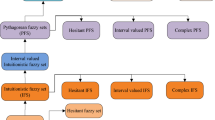Abstract
The primary objective of this work is to put in action a decision making algorithm, based on intuitionistic fuzzy soft set, for making a comparison and selection of the optimally secure S-box, among the several kinds of S-boxes. It is a common fashion to analyze, is to judge quality of S-box by taking into account a single parameter. While we urge to making assessment, about the quality of S-box, by taking into consideration the all parameters collectively, this indeed provides a comprehensive conclusion about the strength of S-box. Moreover, the algorithm also grades the S-boxes on the basis of their strength, and hence process of choosing the secure S-box becomes easier. The proposed method extensively reduces the chances of for piracy in image transmission.

























Similar content being viewed by others
References
Abuelyman, E. S., & Alsehibani, A. A. S. (2008). An optimized implementation of the S-Box using residue of prime numbers. International Journal of Computer Science and Network Security, 8(4), 304–309.
Ahmed N (n.d.). Testing an S-Box for cryptographic use. International Journal of Computer and Electrical Engineering (pp. 1–5).
Atanassov, K. (1999). Intuitionistic fuzzy sets-theory and applications. Heidelberg: Springer.
Cagman, F., Citak, S., & Enginoglu, S. (2011). FP-soft set theory and its applications. Annals of Fuzzy Mathematics and Informatics, 2(2), 219–226.
Cagman, N., & Karatas, S. (2013). Intuitionistic fuzzy soft set theory and its decision making. Journal of Intelligent & Fuzzy Systems, 24, 829–836.
Cui, L., & Cao, Y. (2007). A new S-box structure named affine-power-affine. International Journal of Innovative Computing, Information and Control, 3(3), 45–53.
Daemen, J., & Rijmen, V. (2000). AES Proposal: The design of Rijndael: AES. ISBN 3-540-42580-2.
Data Encryption Standard (DES) (1977) National Bureau of Standards. Federal Information Processing Standard Publication 46.
Jiang, Y., Tanga, Y., Chena, Q., Liu, H., & Tang, J. (2010). Interval-valued intuitionistic fuzzy soft sets and their properties. Computers & Mathematics with Applications, 60, 906–918.
Lui, J., Wai, B., Cheng, X., Wang, X. (2005) An AES S-box to increase complexitsy and cryptgraphic analysis. In International Conference on Advanced Information Networking and Applications (Vol. 1, pp. 724–728).
Haralick, R. M., Shanmugam, K., & Dinstein, I. (1973). Texture features for image classification. IEEE Transactions on Systems, Man, and Cybernetics, 3(6), 610–621.
Hussain, I., Shah, T., & Mehmood, H. (2010). A new algorithm to construct secure keys for AES. International Journal of Contemporary Mathematical Sciences, 5(26), 1263–1270.
Maji, P. K., Biswas, R., & Roy, A. R. (2001). Intuitionistic fuzzy soft sets. Journal of Fuzzy Mathematics, 9(3), 677–692.
Maji, P. K., Roy, A. R., & Biswas, R. (2004). On intuitionistic fuzzy soft sets. Journal of Fuzzy Mathematics, 12(3), 669–683.
Molodtsov, D. (1999). Soft set theory first results. Computers & Mathematics with Applications, 37, 19–31.
Mukherjee, A., & Sarkar, S. (2014). Several similarity measures of neutrosophic soft sets and its application in real life problems. Annals of Pure and Applied Mathematics, 7(1), 1–6.
Medhat, S., & Shah, T. (2013). Intuitionistic fuzzy soft set to grade the S-boxes. Applied Mathematics Informtion Sciences (in press).
Rehman, I., Shah, T. I., & Hussain, I. (2014). Analyses of S-box in image encryption applications based on fuzzy decision making criterion. Zeitschrift für Naturforschung A, 69a, 207–214.
Shi, XY., Xiao, HU., You, XC., Lam, KY. (2002) A method for obtaining cryptographically strong 8 × 8 S-boxes. In International Conference on Information Network Applications (Vol. 2(3), pp. 14–20).
Smarandache, F. (2005). An unifying field in logics: neutrosophic logic, neutrosophy, neutrosophic set, neutrosophic probability and statistics. Rehoboth: American Research Press.
Sung, J., Lee, S., Lim, JI., Hong, S., Park, S. (1976) Provable security for the Skipjack-like structure against differential cryptanalysis and linear cryptanalysis. In ASIACRYPT’00, LNCS (pp. 274–288)
Tran, MT., Bui, DK., Doung, AD. (1998) Gray S-box for advanced encryption standard. In International Conference on Computational Intelligence and Security (pp. 253–256).
Yang, X. B., Lin, T. Y., Yang, J. Y., Li, Y., & Yu, D. (2009). Combination of interval-valued fuzzy set and soft set. Computers & Mathematics with Applications, 58(3), 521–527.
Author information
Authors and Affiliations
Corresponding author
Rights and permissions
About this article
Cite this article
Shah, T., Medhit, S. & Farooq, G. Intuitionistic Fuzzy Soft Set Decision Criterion for Selecting Appropriate Block Cipher. 3D Res 6, 32 (2015). https://doi.org/10.1007/s13319-015-0063-6
Received:
Accepted:
Published:
DOI: https://doi.org/10.1007/s13319-015-0063-6




